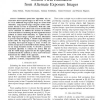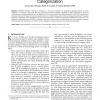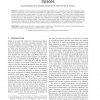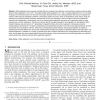116
Voted
PAMI
2011
14 years 3 months ago
2011
—Traditional optical flow algorithms rely on consecutive short-exposed images. In this work, we make use of an additional long-exposed image for motion field estimation. Long-e...
137
click to vote
PAMI
2011
14 years 3 months ago
2011
—CENTRIST (CENsus TRansform hISTogram), a new visual descriptor for recognizing topological places or scene categories, is introduced in this paper. We show that place and scene ...
128
Voted
PAMI
2011
14 years 3 months ago
2011
In this paper we address the problem of tracking an object in a video given its location in the first frame and no other information. Recently, a class of tracking techniques cal...
121
click to vote
PAMI
2011
14 years 3 months ago
2011
Abstract—In this paper, we define meta-recognition, a performance prediction method for recognition algorithms, and examine the theoretical basis for its post-recognition score ...
132
Voted
PAMI
2011
14 years 3 months ago
2011
— This paper addresses how to model and correct image blur that arises when a camera undergoes ego motion while observing a distant scene. In particular, we discuss how the blurr...
115
Voted
PAMI
2011
14 years 3 months ago
2011
—In the research of computer vision and machine perception, three-dimensional objects are usually represented by 2-manifold triangular meshes M. In this paper, we present practic...
137
Voted
PAMI
2011
14 years 3 months ago
2011
—We present a discriminative part-based approach for human action recognition from video sequences using motion features. Our model is based on the recently proposed hidden condi...
127
Voted
PAMI
2011
14 years 3 months ago
2011
— In this paper, we present a method for extracting consistent foreground regions when multiple views of a scene are available. We propose a framework that automatically identi�...
146
Voted
PAMI
2011
14 years 3 months ago
2011
—This paper introduces a square-root velocity (SRV) representation for analyzing shapes of curves in Euclidean spaces under an elastic metric. Due to this SRV representation the ...
134
click to vote
PAMI
2011
14 years 3 months ago
2011
—Affine registration has a long and venerable history in computer vision literature, and in particular, extensive work has been done for affine registration in IR2 and IR3 . This...




